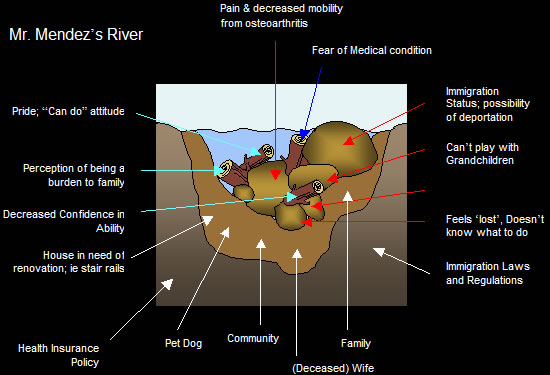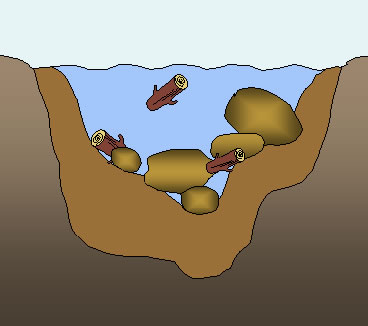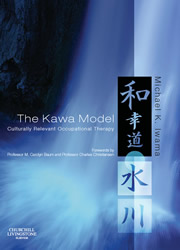Note that this page is continually changing.
In the past 5 years, various groups situated in different locations around the world have developed case studies of the Kawa model’s application in diverse practice contexts. The Tokyo ‘Kawa Model Project group’ headed by Rie Takahashi and Hiroko Yamamoto (nee Fujimoto) has reportedly recorded more than more than 800 case studies, which are used as points of discussion in their monthly practice forums.
Presented below is an abbreviated case study from Toronto, Canada. Its longer rendition can be found as one of a collection of case studies from around the world published in the Kawa Model; Culturally Relevant Occupational Therapy.
All client narratives are regarded to be culturally situated. The Kawa model should not be construed as a universal narrative. Subsequently, occupational therapists will find that their own interpretation and method of applying the kawa model to differ according to the varied cultural situations in which their practice is located. The main objective is to acquire a clear sense of the client as an occupational being in the context of his or her circumstances as the client experiences and views it.
Readers are encouraged to post their case studies on this website, in the forum section to elicit international and inter-cultural discussion. Let us learn from one another, how to deliver as meaningful an occupational therapy as we possibly can.
The Kawa Model as a window into client occupational contexts; the case of Pedro Mendez
Mr. Pedro Mendez has been referred to an out patient rehabilitation program by his physician. He is 66 years old and had come to live with his son’s family in this North-Eastern city almost 4 years ago from Central America. Spanish is Mr. Mendez’s native language but he speaks English well enough for normal conversations.
Mr. Mendez has been diagnosed with osteo-arthritis and his chart reads that he needs some help with his ability to perform his self care and ADL tasks. X-Ray scans have indicated that the osteoarthritis affects Mr. Mendez’s lumbar spine and tight hip. Despite all of your efforts to elicit information from him regarding his meaningful occupations, treatment planning (ie goals) to restore his independence in daily living activities, he seems despondent and at times evasive.
He does not participate in any of the therapeutic group activities, preferring to stay on the periphery. He is not overtly disruptive and usually does what he is asked to do in terms of therapy. When Mr. Mendez is asked about his hobbies and usual routines at home, he defers to his family members to speak for him. “Please ask my son when he comes for me.” In rounds, the team discusses his case and after 2 weeks of the same pattern, comes to the conclusion that he is being ‘non-compliant’ in a ‘passive-aggressive’ kind of way. “He’s just going through the motions… he doesn’t want to be here, so let him finish this week of treatment and discharge him!” your colleagues aver, speaking from a feeling of frustration. “We’ve tried our best. It can’t be helped; it’s his culture”.
The occupational therapist committed to an occupation based view of the client, decides to go beyond the usual rehabilitation service protocols and try an alternate approach based on a framework geared toward understanding the client’s occupational life in a broader context. The Kawa model, a new framework developed outside of the Western hemisphere is tried.
Using the River metaphor as a framework to understand more profoundly the contextual nature of Mr. Mendez’s difficulties and challenges from his perspective, the occupational therapist begins to raise and appreciate the multi-faceted and complex dimensions of his experience of life in the present.
Mr. Mendez’s Kawa
The occupational therapist finds that Mr. Mendez and his family are part of a small, closely knit ethnic community of Guatemalan immigrants. He and his family are careful not to make any trouble nor bring any shame on the community. His care and health seeking behaviour is constrained by the regulations of his health insurance policies and other factors. More than his back pain, which was the reason listed for his referrals, he reveals he is worried about his family situation. His son is apparently having difficulties with his work permit and is resisting deportation. And under these conditions; Mr. Mendez reports that “everything hurts”.
He complains of his nagging back pain; “everything I do hurts… I am afraid to make it worse.” “I am afraid that I cannot perform the usual functions of a man- I can’t even embrace my grandchildren”. “I feel worthless, I cannot help around the house and I have become a burden to my family. I have lost confidence in my abilities. Mr. Mendez is often heard whispering to his wife, who passed away a year ago. When asked about who he is speaking with, tears well up in his eyes while he replies- “oh, I miss her so terribly; I talk with her all the time”.
If I can get better, the first thing I want to do is play with my grandchildren, and of course, take my dog to the park twice a day.
The therapist sits down with Mr. Mendez and his life situation, past and present, is talked about through the River metaphor. A therapeutic relationship of trust begins to form as the therapist listens to the client and verifies the symbolic meaning of the river drawing and its emerging components.

Figure 1: Cross sectional view of Mr. Mendez’s river, summarizing important aspects of his occupational context
Mr. Mendez’s river (life force) is flowing weakly. The impedance to flow is due to a complex collection of numerous factors (such as physical ,social, political, medical, financial) that are interconnected.
Table 1: Inventory of Pedro Mendez’s occupational issues categorized according to Kawa model concepts.
| Kawa Concept | Definition | Client Centred Issues |
|---|---|---|
| Rocks | Discrete circumstances that are considered to impede one’s water or life-flow. They are life circumstances perceived by the client to be problematic and difficult to remove. |
|
| River Walls & Bottom | The client’s environment, in the context of being inseparable from all of the other river structures- namely water and rocks. | Micro level:
Macro level
|
| Driftwood | The client’s personal attributes and resources, that can positively or negatively affect the subject’s circumstance and life flow. They are transient in nature. |
|
| Water | The subject’s life energy or life flow |
|
| Spaces and Gaps | Occupational Therapy |
|
Some may argue that problems like ‘the fear of deportation’, which has political and socio-economic relevance, is not an occupational therapy issue,. From the viewpoint of the Kawa framework, occupation is inextricably tied to matters of life, and any contextual factor that impacts on or influences the form, function and meaning of occupations, qualifies as an occupational therapy interest. The beauty, power and promise of occupational therapy have always resided in its holistic regard for the client, appreciated in context. The intervention may involve or even be carried out by other health professionals but the relation between these factors and a client’s occupations are nonetheless monitored.
Table 2: Possible occupational therapy interventions for Pedro Mendez’s occupational issues, categorized according to Kawa model concepts.
| Kawa Concept | Client Centred Issues | Occupational Therapy Actions |
|---|---|---|
| Rocks |
|
|
| River Walls & Bottom | Micro level:
Macro level
|
|
| Driftwood |
|
|
| Water |
|
|
Using to the river framework to explicate the complex context of Mr. Mendez’s circumstances, the OT begins to identify those channels where Mr. Mendez’s life (water) continues to flow. These channels are bounded by his existing problems and challenges (Rocks), residual abilities and liabilities (Driftwood), and aspects of his physical and social environment (River walls and sides). Intervention is, like his circumstances, multi-faceted, involving a combination of foci and approaches. Rocks might be eroded through a variety of approaches and interventions, including the use of purposeful activity and education. For example, the river walls and bottom might be expanded through family and client discussions to facilitate greater understanding and support for Mr. Mendez. Modifications to his home environment might be targeted to enable greater ability and safety. A social worker and psychologist may be brought in for delicate matters requiring counseling. Advocacy for Mr. Mendez’s family in accessing legal counsel for immigration issues maybe in order.
As the river contents and structure expand, the channels become wider, and the client’s life force is liberated to flow more strongly and fully. The essence of occupational therapy from this regard is to enhance or enable greater life flow. If matters of occupation are supposed to be at the centre of occupational therapy, then its approaches ought to be comprehensive, contextual and client centred. As more information emerges about the characteristics of Mr. Mendez’s river, the intervention becomes more profound and focused.

Figure 2: A more comprehensive and multifaceted occupational therapy approach to Mr. Mendez’s situation has resulted in stronger life flow. Note that all impediments to flow have not been totally eliminated. Many of the structures have reduced in size and shape, contributing to better flow. Like most people’s lives, some struggles and challenges remain and are part of most life experiences.
